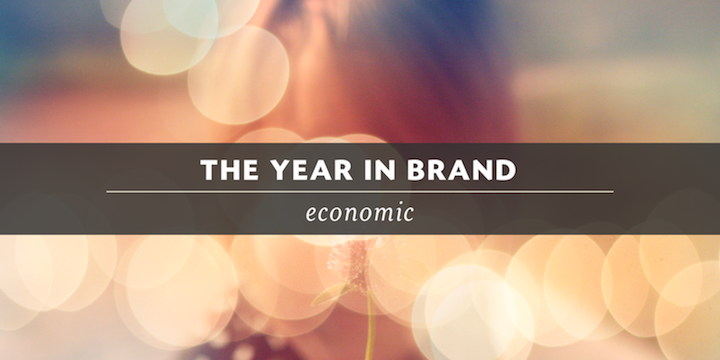Davis Brand Brief: The Year in Brand

Strong brands keep promises, make connections and create engaging consumer experiences. 2013 defined the Year of Experience, as brand strategies focused on new ways to involve consumers.
From image-driven social media to fresh-from-the-lab retail displays, the year’s most memorable brands connected with consumers in more meaningful ways in person and online.

Brand as Platform
“User experience” no longer belongs just to tech companies. It now drives brand strategies all over the globe. This year, the most dynamic brands served as platforms for tangible experiences that brought their stories to life.
Nike wins the race, expanding from a sports brand to a lifestyle platform as it “brings inspiration and innovation to every athlete in the world.” The Nike+ Kinect partnership with the newly launched Xbox One united the two brands on a platform that the consumer embraced. Disney made the Happiest Place on Earth even happier through the vacation management system MyMagic+, a rubber bracelet designed to streamline and enhance the visitor experience. Amazon’s prototype of the PrimeAir drone, while grounded for now, changes the way we think about logistics, delivery and instant gratification.
On the brick-and-mortar level, retail brands found opportunities to use their physical spaces, creating unique brand experiences to provide memorable escapes from the everyday. In time for the holidays, department stores Saks, Barneys and Macys revamped consumer experience through high-tech holiday display windows utilizing 3D projection mapping and interactive mobile windows. At the same time, large-scale retailers gave consumers a multi-sensory shopping experience by leveraging new technology, such as Ultrahaptics, on touchscreens and maps.
As “innovation” continues to be a buzzword that is losing meaning, brands create new ways to make every consumer interaction extraordinary. We look to 2014 to raise the bar even higher.

In with the New, Out with the Old
2013 marked the rise of new, dynamic experiences and the death of old, static experiences. Twitter’s highly successful IPO wowed Wall Street, as Apple was named the most valuable brand and Netflix made a huge comeback, past-their-prime brands JC Penney and Sears suffered loss of face and legal mayhem with flagship brands.
To stay competitive and prevent “window shopping,” Target promised early this year to match prices found on online retail competitors, including Amazon.com, ToysRUs.com and BestBuy.com. This pricing play removes a step for consumers and lowers the risk of lost sales for Target, though it also makes the stores less of a special destination and place of discivery. Meanwhile, the less kid-glove Wal-Mart received a black eye on Black Friday by cultivating an environment suited for brawls. The promise of "Save Money. Live Better." seemed decidely one-sided.
Iconic brands reinvented themselves this year, too. When Hostess filed for bankruptcy and took Twinkies off the shelf in 2012, brand loyalists lamented the demise of cakey goodness. When the brand re-launched in 2013, Hostess invited public rejoicing through Vine and Instagram, launched a fleet of food trucks, and sent the “Twinkie the Kid” mascot on a national tour, successfully targeting a new audience: dudes. The efforts paid off in a big way — sales of Hostess products are seven times greater than historic levels. Up-market, Burberry, once considered stodgy and boring, reinvented itself with a strong digital strategy, achieving market dominance in a still-recessionary climate.
When failing to connect with consumers, brands lose meaning and economic footing, sometimes on a grand scale. In the “Zen” world of yoga, things got turned upside-down. Lululemon toppled off-balance with a series of blunders, ranging from supply chain issues to publicly insulting consumers. Surprisingly, brand revenues did not bend over. It remains to be seen, however, if new leadership and improved operations will strengthen the brand’s core in 2014. And … breathe.

Brand Experience as Cultural Currency
In a time when branded content earns equal space alongside our friends in daily newsfeeds, it becomes critical for stories to be both timely and distinct. Today’s social media-based environment demands an understanding of culture that shapes good branding.
Brands, like people, possess the power to change the world, and consumers find kinship with brands that echo their values. As brands help consumers express and discover what they value, the companies managing them must be ready to respond to consumer behavior shifts without moving away from their promises.
Now more than ever, brands serve as arbiters of social good, lead as moral guides and participate in social agendas. Earlier this year, Chipotle made a statement with its follow up to the hugely successful “Back to the Start.” “The Scarecrow,” an animated short about factory farming defines, on the video and cultural fronts, conversations about sustainable and humane practices. Chipotle extends the dialogue through a content partnership with the Huffington Post called Food for Thought. Dedicated to creating awareness about how food is grown, raised, and prepared and the effects this system has on us, Food for Thought positions Chipotle as a critical part of life outside of its restaurant walls.
Skype’s powerful Stay Together campaign illustrates the brand’s promise of connecting people across life’s changes and geographies. Showing conversations taking place via tablets, projected on walls, and allowing loved ones to “stand next” to one another for virtual group photos brings awareness to what happens when people choose Skype.
In the non-profit sector, the Make-A-Wish Foundation’s awe-inspiring Batkid amazed America, unified a city, and brought non-profits into the age of virtual social interaction. In a similar vein, HRC redefined what social media can do for a social agenda and moved millions to turn Facebook red for equality.
Whether NASA prints a pizza, or a Texas company prints metal guns, 3D printers changed the way we think about product production and brand management, putting consumers in control of both like never before. This age of instantaneous creation calls the question between authenticity and knock off, making brand more important than ever.
The rise of the Relationship Economy also defined 2013. Successful brands focused on understanding consumer motivations, leveraging brand meaning to drive margins. Key examples in the beauty category include Dove’s Real Beauty Sketches and Beautycounter’s launch.
With this vast universe of opportunity comes the risk of losing consumer engagement if brands fail to be genuine in meeting the multifaceted demands of the consumer. Cases in point: Xbox One’s sexist web-based advertisement that subscribed to the out-of-date notion that boys love games and women love to knit, and Hyundai’s “Pipe Job” ad that made light of suicide.

The Beauty of Imperfection
Creative brand expression today requires an emphasis on being genuine rather than being perfect. In 2013, brand design trended toward the simple, clean and flat. Both Facebook and Apple returned to flat design, meeting consumer preference for visual cues that are authentic rather than complex and embellished.
The introduction of Instagram video and Vine make it imperative for brands to express themselves more in-the-moment. Studies show that 40 percent of the most popular videos currently on Instagram are from brands, not people.
Progressive’s new advertising campaign, “The Thread,” noticeably Flo-less, uses the idea and imagery of the apron as a nod to real-world hard work and the company’s values. While Flo will remain the centerpiece of Progressive’s advertising, the tonality of the new campaign captures a sense of every day realness rather than humor. Along the same lines, Dick’s Sporting Goods’ “The Pitch,” focuses on the grit and tension of the baseball playing field rather than cinematic wins. On the flipside of authentic, see Facebook’s “Chair,” which compared the social network’s meaning to that of the universe. The campaign ignored the real nature of relationships and, in turn, consumers rejected it as well.
With the imperative to create engaging consumer experiences, brands willing to take creative risks see the biggest payoffs. Kmart surprised consumers this year with “Ship My Pants,” Volvo shocked the world with the Jean-Claude Van Damme “Epic Split,” and Canadian airline WestJet flawlessly executed the “Christmas Miracle” campaign. In 2013, breakthrough work equated risk-tolerant clients.
Several major companies changed their logos this year, some for the better, some for the worse. Art may be in the eye of the beholder, but creative expression of brands reside in the eye of the consumer. It will be thrilling to see if the appeal of imperfection endures in 2014.

